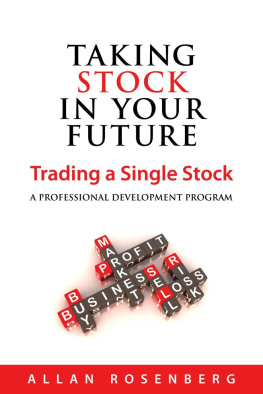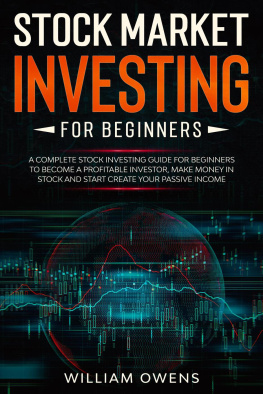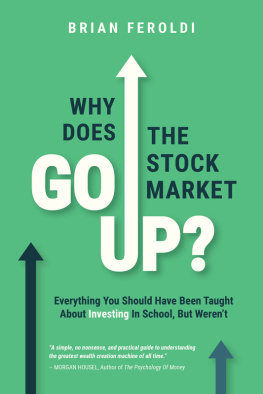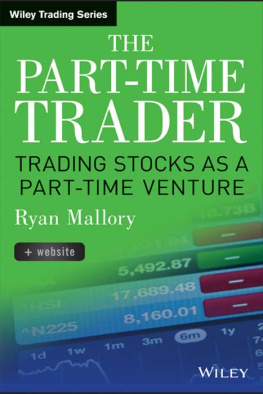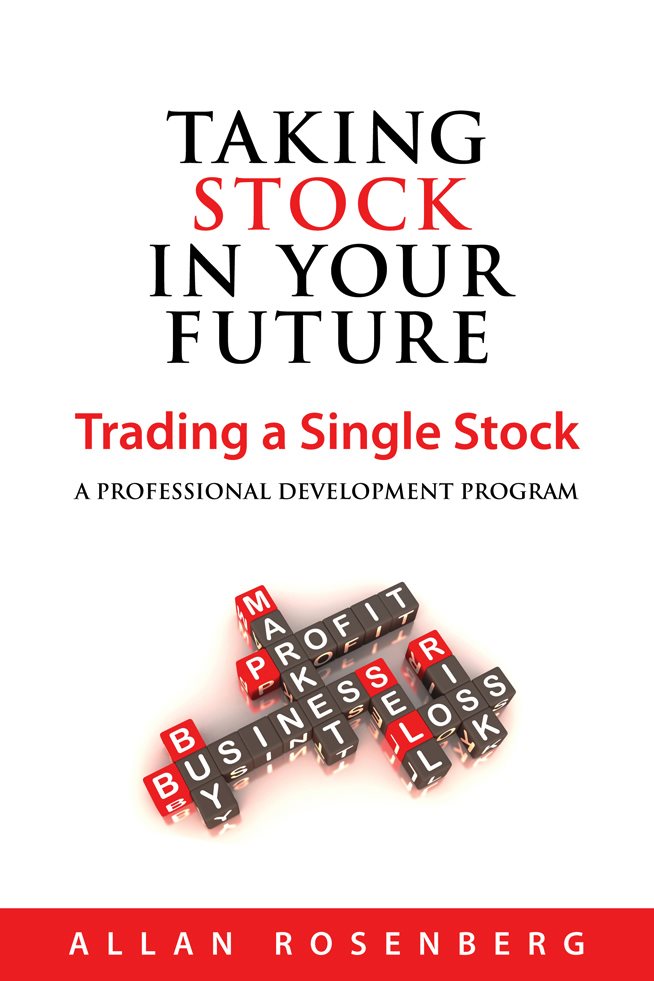
Taking Stock In Your Future
TRADING A SINGLE STOCK:
A Professional Development Program
ALLAN ROSENBERG
Copyright 2012, Allan Rosenberg
NOTICE AND DISCLAIMER: All rights reserved. No part of this publication may be reproduced, stored in a retrieval system, or transmitted, in any form or by any means, electronic, mechanical, photocopying, recording or otherwise, without the prior writen consent of the publisher.
All persons involved in the preparation and sale of this publication disclaim any warranty as to accuracy or currency of the publication. This publication is provided on the understanding and basis that none of the author or other persons involved in the creation of this publication shall be responsible for the accuracy or currency of the contents, or for the results of any action taken on the basis of the information contained in this publication, or for any errors or omissions contained herein.
No one involved in this publication is attempting herein to render financial, accounting or other professional advice. If financial advice or other expert assistance is required, the services of a competent professional should be sought. The analysis contained herein should in no way be construed as being either official or unofficial policy of any governmental body.
Editing: Catherine Leek of Green Onion Publishing
Cover and Interior Design and Layout: Kim Monteforte of WeMakeBooks.ca
Table of Contents
Our Approach and Philosophy
Value Investing
Selecting Stocks Under Value Investing
Technical Analysis
Selecting Stocks Under Technical Analysis
Your Commitments
Money
Your Time
What Youll Need to Succeed
The Markets Cycles
Your Approach: Short-Term Trading
The Basics
Cyclical Companies by Category
Financial Goals
Profitability
Stability
Liquidity
Efficiency
Growth
Financial Analysis
Supply and Demand
The Cycle of a Stock
Stage One
Stage Two
Stage Three
Stage Four
Support and Resistance
Adding Emotion to the Cycle
Putting It Together
Six Ways Financial Markets Affect Companies
Anatomy of an Uptrend
Anatomy of a Downtrend
Going Public
Underwriting
Reading a Company
Questions and Answers
How Stock Markets Work
Market Types
Commodity Markets
Futures Contracts
The Exchanges
The NASDAQ
The American Stock Exchange LLC
The Securites Exchange Commission (SEC)
Securities and Exchange Commission Reports
The Indices
The Dow Jones Industrial Average
The NYSE Composite Index
Standard & Poors 500 Index
Lessons Learned from the Past
Lessons from the 1980s
Todays Considerations
Selecting an Online Broker
Products and Services
Interim Statements
Determining the Health of a Stock
Fundamental Analysis
Technical Analysis
The IDB
Charting Basics
Charting Essentials: Line Charts, Bar Charts and Candlestick Charts
Line Charts
Bar Charts
Candlestick Charts
Candlestick Charting Features
Basic Candlestick Patterns
Hammer and Hanging Man
Two-Candlestick Patterns
Three-Candlestick Patterns
Spinning Tops and High Wave Candlesticks
Questions and Answers
Reading the Charts
Your Traders Toolbox
Volume: A Mega-Important Indicator
Moving Averages
Oscillators
On-Balance Volume
The MACD
MACD-H Signals
Bollinger Bands
Head-and-Shoulders
The Key Points
The Graph
Reverse Head-and-Shoulders
The Key Points
The Graph
Cup-with-Handle
The Key Points
The Graph
Double Bottom
The Key Points
The Graph
Double Top
The Key Points
The Graph
Gaps: A Traders Black Hole
Exhaustion Gaps
Some Graphs
Case Study: Harrier Inc.
Buy Trigger List
Questions and Answers
Plan Your Trade and Trade Your Plan
Guidelines
Stop-Loss
Fibonacci Numbers
The Markets Daily Rhythms
Advance/Decline Line: Market Narrator in a Capsule
Economic Indicators
Inflation Facts
Bull/Bear Ratio
Other Indicators
A Word about Losses
Level II Trading: Is It for You?
Setting Up a Trading Log
Is This a Good Trade?
Buying More of One Stock
High-Risk Trade
Reducing Risk
Working a Real Trade
The Stats
The Journey
The Rest of the Story
The Big Picture
Assess the Trading Environment
Analyze the Broader Markets
Gold
Questions and Answers
Appendices
Key Terms
Formulas
The Balance Sheet
Various Types of Stocks
Preface
In my time as a trader/ speculator/investor I have come to read many books and publications about Wall Street and the stock market some useful but most not. It is interesting to note that more money has been made on Wall Street authoring books, writing newsletters, and giving seminars than on speculation itself. This may not seem obvious to the public today given the fact that the greatest bull market in history has just ended but in due time, I believe this fact will be made clear to most people.
It is my hope that Taking Stock in Your Future will help my read ers gain a better understanding of the stock market and trading in gen eral. I believe that those who truly take the time to study stock market history will greatly benefit from this text. There is really no magic formula to making money in the stock market. To truly succeed one must put in the time and effort, especially since trading or speculat ing in the stock market is, in my opinion, the most competitive profession there is today.
The principles I present here are not without their share of detractors. For example, many professional money managers regard the concepts presented in this book as basic or, worse yet, unworkable in todays institutional model a model where guaranteed and steady inflows into equities from global pension funds, sovereign wealth funds, company buybacks, and retail investors have moder ated the volatile cycles of yester-years. A prominent hedge fund manager (whose hedge fund operations have blown up twice in the last decade) even went as far as calling one of Benjamin Grahams value investing methods, that of buying a company for less than its net current value, ridiculous in todays environment. (More on Graham, a professor and investment theorist, later.)
In my opinion, there are two major reasons why Taking Stock in Your Future is as relevant as ever, if not more.
- The teaching within still forms the foundation of all types of value investing practiced in the world today. To get a sense of how the concept of value investing has evolved over the last 60 years, it is imperative for investors to go back to the true source. Moreover, the ideas put forward are easily accessible to both the lay investor and the professional alike.
- Like the vast majority of the general population, many professional investors are not immune to temporary lapses in investment discipline. Having a copy of Taking Stock in Your Future sitting on your desk or the nearest book shelf is a great antidote to such lapses especially in trying times such as we experienced in October 2008.
The primary purpose of this book is to supply, in a form suitable for laypeople, guidance in the adoption and execution of an investment policy. Comparatively little will be said here about investment principles and investors attitudes, rather attention will be paid chiefly to the technique of analyzing securities.

